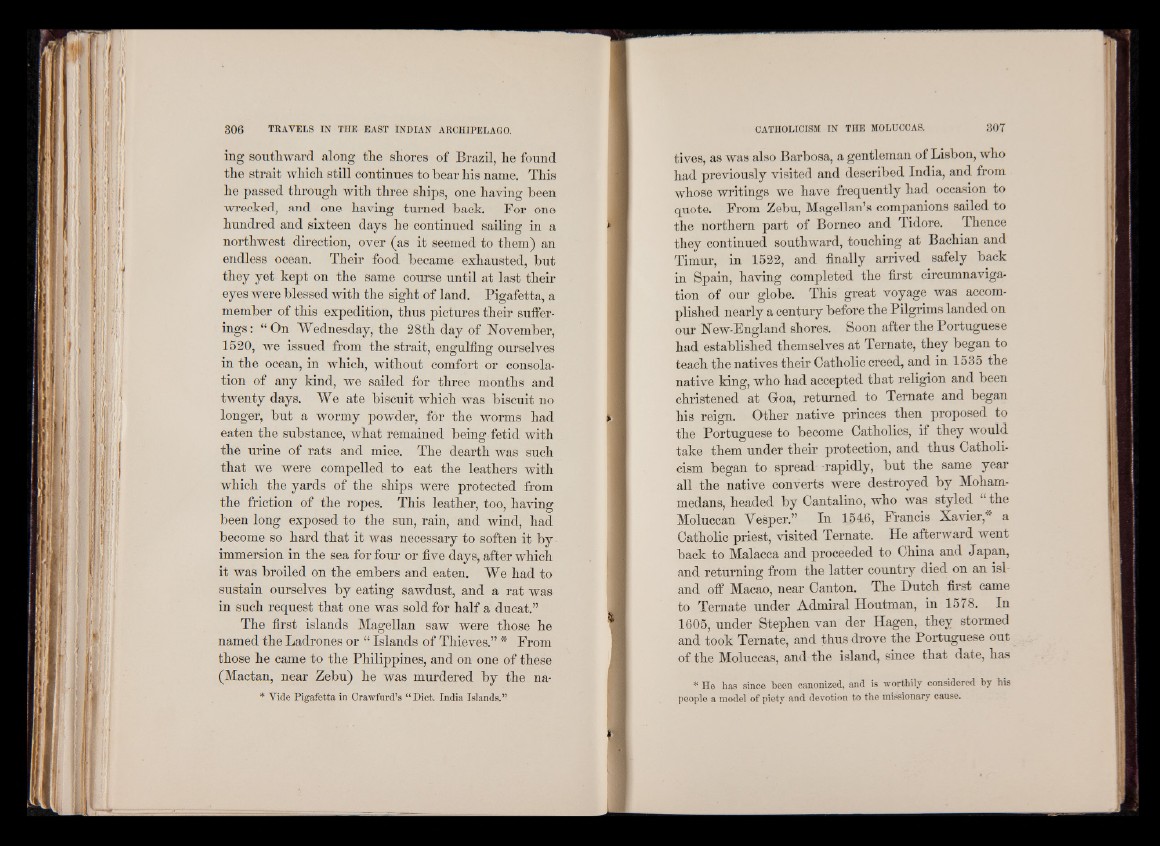
ing southward along the shores of Brazil, he found
the strait which still continues to bear his name. This
he passed through with three ships, one having been
wrecked, and one having turned back. For one
hundred and sixteen days he continued sailing in a
northwest direction, over (as it seemed to them) an
endless ocean. Their food became exhausted, but
they yet kept on the same course until at last their
eyes were blessed with the sight of land. Pigafetta, a
member of this expedition, thus pictures their sufferings:
“ On Wednesday, the 28th day of November,
1520, we issued from the strait, engulfing ourselves
in the ocean, in which, without comfort or consolation
of any kind, we sailed for three months and
twenty days. We ate biscuit which was biscuit no
longer, but a wormy powder, for the worms had
eaten the substance, what remained being fetid with
the urine of rats and mice. The dearth was such
that we were compelled to eat the leathers with
which the yards of the ships were protected from
the friction of the ropes. This leather, too, having
been long exposed to the sun, rain, and wind, had
become so hard that it was necessary to soften it by
immersion in the sea for four or five days, after which
it was broiled on the embers and eaten. We had to
sustain ourselves by eating sawdust, and a rat was
in such request that one was sold for half a ducat.”
The first islands Magellan saw were those he
named the Ladrones or “ Islands of Thieves.” * From
those he came to the Philippines, and on one of these
(Mactan, near Zebu) he was murdered by the na-
* Yide Pigafetta in Crawfurd’s “ Diet. India Islands.”
tives, as was also Barbosa, a gentleman of Lisbon, who
had previously visited and described India, and from
whose writings we have frequently had occasion to
quote. From Zebu, Magellan’s companions sailed to
the northern part of Borneo and Tidore. Thence
they continued southward, touching at Bachian and
Timur, in 1522, and finally arrived safely back
in Spain, having completed the first circumnavigation
of our globe. This great voyage was accomplished
nearly a century before the Pilgrims landed on
our New-England shores. Soon after the Portuguese
had established themselves at Temate, they began to
teach the natives their Catholic creed, and in 1535 the
native king, who had accepted that religion and been
christened at Goa, returned to Ternate and began
his reign. Other native princes then proposed to
the Portuguese to become Catholics, if they would
take them under their protection, and thus Catholicism
began to spread rapidly, but the same year
all the native converts were destroyed by Mohammedans,
headed by Cantalino, who was styled “ the
Moluccan Vesper.” In 154.6, Francis Xavier,* a
Catholic priest, visited Ternate. He afterward went
back to Malacca and proceeded to China and Japan,
and returning from the latter country died on an island
off Macao, near Canton. The Hutch first came
to Temate under Admiral Houtman, in 1578. In
1605, under Stephen van der Hagen, they stormed
and took Ternate, and thus drove the Portuguese out
of the Moluccas, and the island, since that date, has
* He Has since been canonized, and is worthily considered by his
people a model of piety and devotion to the missionary canse.